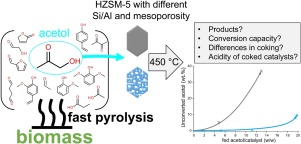Catalysis Today ( IF 5.2 ) Pub Date : 2020-03-18 , DOI: 10.1016/j.cattod.2020.03.041 Andreas Eschenbacher , Jakob Afzali Andersen , Anker Degn Jensen

|
Crude bio-oil from fast pyrolysis of biomass has a high oxygen content and acidity, leading to problems with corrosion and polymerization/instability. In this work, the catalytic vapor phase upgrading of acetol, a compound that is present in high concentrations in pyrolysis vapors, was investigated over three microporous HZSM-5 and four mesoporous HZSM-5 catalysts with different levels of acidity and mesoporosity. All catalysts were steam-treated prior to testing in order to attribute deactivation unambiguously to coking rather than simultaneously occurring dealumination, and catalysts were characterized by Argon and N2 physisorption, NH3-TPD, Pyridine-IR, TEM, and XRD. With increasing temperature, the gas yield increased between 400 and 500 °C while the coke yields decreased, along with increased acetol conversion and increased selectivities to oxygen-free hydrocarbons in the liquid phase. Catalyst screening was conducted at 450 °C by studying the conversion of acetol as a function of increased amounts of fed reactant. CO and ethene were the major reaction products in the gas phase. At high conversions, the condensed liquid contained olefins such as iso-butene and BTX monoaromatics. With increasing amounts of fed acetol, the selectivity to oxygen-free hydrocarbons decreased while the concentration of oxygenated compounds such as ethers, ketones, and furans increased. Simultaneously, coke formation rapidly decreased the weak and strong acid sites of the zeolites. A maximum monoaromatics yield of ∼5 wt.% of fed acetol was achieved in the initial upgrading phase for the purely microporous zeolites with Si/Al = 15 and 29, while mesoporous HZSM-5 showed slightly lower yields of monoaromatics. While the coking propensity increased after introduction of mesopores, all mesoporous catalysts showed an improved capacity for converting acetol compared to their microporous versions. Mesoporous HSZM-5 prepared via desilication of parent HZSM-5 (Si/Al = 15) with a mixture of NaOH and a pore-directing agent showed the highest tolerance towards deactivation, which is attributed to a favorable combination of acid strength and preservation of crystallinity and microporous volume with well distributed mesopores improving the accessibility of reactants to active sites.
中文翻译:

HZSM-5催化剂上丙酮醇的催化转化– Si / Al比的影响和介孔率的引入
来自生物质快速热解的粗制生物油具有较高的氧含量和酸度,从而导致腐蚀和聚合/不稳定性问题。在这项工作中,对三种酸度和介孔水平不同的三种微孔HZSM-5和四种介孔HZSM-5催化剂,研究了丙酮醇(一种高浓度存在于热解蒸气中的化合物)的催化汽相转化。在测试之前,对所有催化剂进行蒸汽处理,以便明确地将失活归因于焦化而不是同时发生的脱铝,并且通过氩气和N 2物理吸附,NH 3对其进行表征。-TPD,吡啶-IR,TEM和XRD。随着温度的升高,气体收率在400至500°C之间增加,而焦炭收率则下降,同时丙酮醇转化率增加,液相中对无氧烃的选择性增加。通过研究丙酮醇的转化率与进料反应物数量增加的关系,在450°C进行催化剂筛选。CO和乙烯是气相中的主要反应产物。在高转化率下,冷凝的液体包含烯烃,例如异丁烯和BTX单芳族化合物。随着进料丙酮醇量的增加,对无氧烃的选择性降低,而含氧化合物(如醚,酮和呋喃)的浓度增加。同时,焦炭的形成迅速降低了沸石的弱酸和强酸位。对于Si / Al = 15和29的纯微孔沸石,在最初的提纯阶段,单醇的最大单芳烃收率达到了约5 wt。%,而中孔HZSM-5的单芳烃收率略低。尽管在引入中孔后焦化倾向增加,但与它们的微孔形式相比,所有中孔催化剂均显示出更高的转化丙酮醇的能力。通过将母体HZSM-5(Si / Al = 15)与NaOH和造孔剂的混合物脱硅制得的介孔HSZM-5显示出最高的抗失活耐受性,这归因于酸强度和防腐剂的良好结合。具有良好分布的中孔的结晶度和微孔体积提高了反应物到活性位点的可及性。对于Si / Al = 15和29的纯微孔沸石,在初始提纯阶段可达到%的进料丙酮醇,而中孔HZSM-5的单芳烃收率略低。尽管在引入中孔后焦化倾向增加,但与它们的微孔形式相比,所有中孔催化剂均显示出更高的转化丙酮醇的能力。通过将母体HZSM-5(Si / Al = 15)与NaOH和造孔剂的混合物脱硅制得的介孔HSZM-5显示出最高的抗失活耐受性,这归因于酸强度和防腐剂的良好结合。具有良好分布的中孔的结晶度和微孔体积提高了反应物到活性位点的可及性。对于Si / Al = 15和29的纯微孔沸石,在初始提纯阶段可达到%的进料丙酮醇,而中孔HZSM-5的单芳烃收率略低。尽管在引入中孔后焦化倾向增加,但与它们的微孔形式相比,所有中孔催化剂均显示出更高的转化丙酮醇的能力。通过将母体HZSM-5(Si / Al = 15)与NaOH和造孔剂的混合物脱硅制得的介孔HSZM-5显示出最高的抗失活耐受性,这归因于酸强度和防腐剂的良好结合。具有良好分布的中孔的结晶度和微孔体积提高了反应物到活性位点的可及性。而介孔HZSM-5的单芳烃收率略低。尽管在引入中孔后焦化倾向增加,但与它们的微孔形式相比,所有中孔催化剂均显示出更高的转化丙酮醇的能力。通过将母体HZSM-5(Si / Al = 15)与NaOH和造孔剂的混合物脱硅制得的介孔HSZM-5显示出最高的抗失活耐受性,这归因于酸强度和防腐剂的良好结合。具有良好分布的中孔的结晶度和微孔体积提高了反应物到活性位点的可及性。而介孔HZSM-5的单芳烃收率略低。尽管在引入中孔后焦化倾向增加,但与它们的微孔形式相比,所有中孔催化剂均显示出更高的转化丙酮醇的能力。通过将母体HZSM-5(Si / Al = 15)与NaOH和造孔剂的混合物脱硅制得的介孔HSZM-5显示出最高的抗失活耐受性,这归因于酸强度和防腐剂的良好结合。具有良好分布的中孔的结晶度和微孔体积提高了反应物到活性位点的可及性。与它们的微孔形式相比,所有的介孔催化剂都具有更高的转化丙酮醇的能力。通过将母体HZSM-5(Si / Al = 15)与NaOH和造孔剂的混合物脱硅制得的介孔HSZM-5显示出最高的抗失活耐受性,这归因于酸强度和防腐剂的良好结合。具有良好分布的中孔的结晶度和微孔体积提高了反应物到活性位点的可及性。与它们的微孔形式相比,所有的介孔催化剂均具有更高的转化丙酮醇的能力。通过将母体HZSM-5(Si / Al = 15)与NaOH和造孔剂的混合物脱硅制得的介孔HSZM-5显示出最高的抗失活耐受性,这归因于酸强度和防腐剂的良好结合。具有良好分布的中孔的结晶度和微孔体积提高了反应物到活性位点的可及性。











































 京公网安备 11010802027423号
京公网安备 11010802027423号